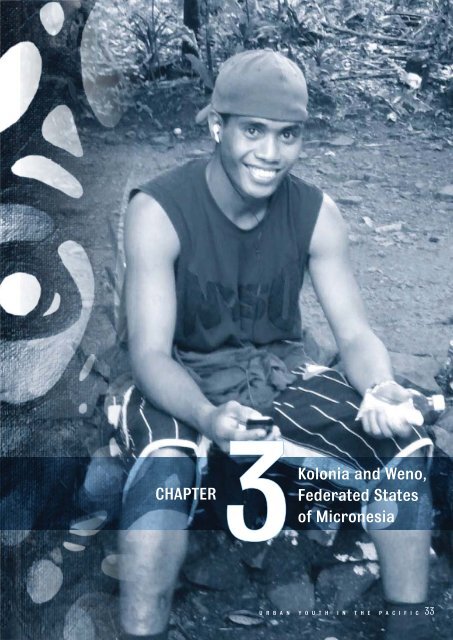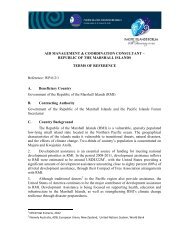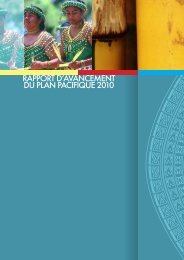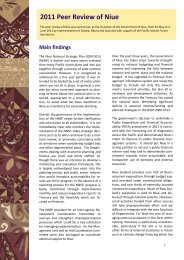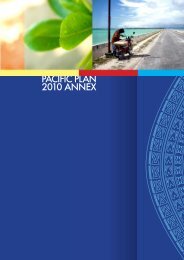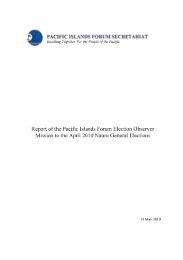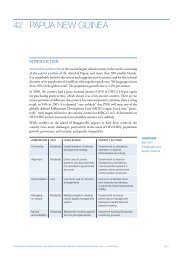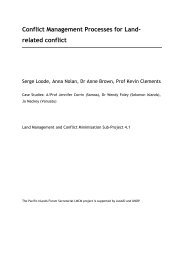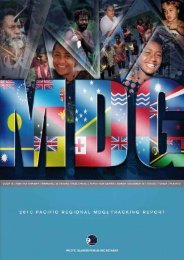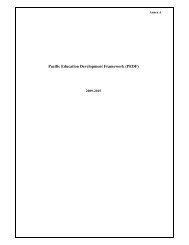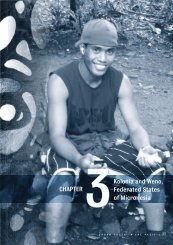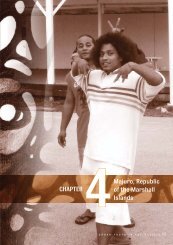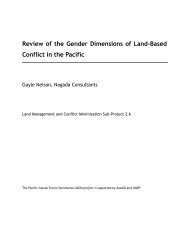Kolonia and Weno, Federated States of Micronesia CHAPTER 3 ...
Kolonia and Weno, Federated States of Micronesia CHAPTER 3 ...
Kolonia and Weno, Federated States of Micronesia CHAPTER 3 ...
You also want an ePaper? Increase the reach of your titles
YUMPU automatically turns print PDFs into web optimized ePapers that Google loves.
<strong>CHAPTER</strong>3<br />
<strong>Kolonia</strong> <strong>and</strong> <strong>Weno</strong>,<br />
<strong>Federated</strong> <strong>States</strong><br />
<strong>of</strong> <strong>Micronesia</strong><br />
U R B A N Y O U T H I N T H E P A C I F I C 33
34<br />
3<br />
Chapter Three:<br />
<strong>Kolonia</strong> <strong>and</strong> <strong>Weno</strong>,<br />
<strong>Federated</strong> <strong>States</strong><br />
<strong>of</strong> <strong>Micronesia</strong><br />
3.1 Introduction<br />
U R B A N Y O U T H I N T H E P A C I F I C<br />
This Urban Centre Case Study discusses youth crime <strong>and</strong> violence in <strong>Kolonia</strong>, Pohnpei <strong>and</strong><br />
<strong>Weno</strong>, Chuuk. The research team conducted focus groups discussions <strong>and</strong> interviews in<br />
<strong>Kolonia</strong> <strong>and</strong> <strong>Weno</strong>. Consultations included young people, government actors <strong>and</strong> civil society<br />
organizations which provided the main basis for the findings. Additionally, a desk review <strong>of</strong><br />
available reports <strong>and</strong> statistics was conducted. This case study includes a set <strong>of</strong> specific<br />
national recommendations for consideration by policy-makers, as well as community<br />
stakeholders <strong>and</strong> the donor community.<br />
Just as the nation itself is young, having emerged from United <strong>States</strong> trusteeship to<br />
independence in 1986, the population <strong>of</strong> the <strong>Federated</strong> <strong>States</strong> <strong>of</strong> <strong>Micronesia</strong> (FSM) is also<br />
young with an average age <strong>of</strong> 18.9 years old. 29 The National Youth Policy 2004-2010 defines<br />
young people as between 15 <strong>and</strong> 34 years <strong>of</strong> age. 30 In the formal justice system, juveniles are<br />
defined as young people aged 17 <strong>and</strong> younger. Within the community context, a more flexible<br />
definition is <strong>of</strong>ten used; youth are considered to be young people who are not married <strong>and</strong><br />
are still financially dependent, with no clearly set age limit.<br />
In FSM cultural <strong>and</strong> societal changes in family structures, insufficient education <strong>and</strong><br />
employment opportunities, limited access to community activities <strong>and</strong> the easy access to<br />
alcohol <strong>and</strong>/or drugs have all combined to create an environment that can at times put<br />
young people at risk. The lifestyle choices <strong>and</strong> environment that young people face today<br />
are very different from those <strong>of</strong> just two generations ago. The society as a whole has shifted<br />
from a reliance on subsistence agriculture <strong>and</strong> fishing to a cash economy where the biggest<br />
formal sector employer is the Government. Social <strong>and</strong> family structures have also changed<br />
leaving young people with less support than previous generations.<br />
Despite the range <strong>of</strong> challenges many young people are grappling with, it is encouraging<br />
that most young people continue to contribute positively to their communities. Nonetheless,<br />
some young people are still struggling to adapt <strong>and</strong> a minority, in particular young men,<br />
have become involved in crime. Serious crime is not common, but misdemeanours that<br />
are frequently committed by young people include theft, v<strong>and</strong>alism, drunk <strong>and</strong> disorderly<br />
conduct, <strong>and</strong> breaking <strong>and</strong> entering. Of concern is the fact that many young men <strong>and</strong> women<br />
are also exposed to violence, whether in the public or domestic sphere. This interaction<br />
between young people <strong>and</strong> violence undermines their capacity to effectively contribute to<br />
their communities <strong>and</strong> to grow into healthy, engaged <strong>and</strong> contributing citizens.<br />
3.2 National Context<br />
FSM comprises four states, each with its own language <strong>and</strong> culture <strong>and</strong> each presenting<br />
youth with a unique setting. FSM is ranked as a Medium Human Development country at<br />
number 103 out <strong>of</strong> 169 countries according to UNDP’s 2010 Human Development Index. 31<br />
FSM’s human development ranking has not risen since 2005, despite a seven percent rise in<br />
the regional index over the same period, indicating persistent stagnancy in development. 32<br />
However, poverty is not pervasive in FSM <strong>and</strong> there is debate about the applicability <strong>of</strong> the<br />
term itself. ‘Hardship’, is the term used in local development circles in FSM as it implies<br />
inadequate access to basic services, opportunities to participate in socio-economic life, <strong>and</strong><br />
to meet basic needs. In this sense, hardship is relatively widespread. 33<br />
29 SBOC 2008.<br />
30 HSA 2005.<br />
31 UNDP 2010a.<br />
32 UNDP 2010b. Regional index refers to East Asia <strong>and</strong> the Pacific.<br />
33 SBOC 2008 <strong>and</strong> UNDP 2010.
The last National Census, which was undertaken in 2000, found that the total<br />
population <strong>of</strong> FSM is 107,000 34 <strong>of</strong> which 38 percent (or 41,000 people) fall<br />
within the FSM definition <strong>of</strong> youth (Figure 3.1). 35 The FSM population is<br />
young, with an average age <strong>of</strong> just 18.9 years. The annual growth rate<br />
has slowed to approximately 0.3 percent as <strong>of</strong> 2000. 36 High birth rates<br />
are countered by high out-migration rates, resulting in a minimal<br />
growth rate. Approximately, over half the total population live in the<br />
State <strong>of</strong> Chuuk <strong>and</strong> one third in the State <strong>of</strong> Pohnpei. 37 Chuuk is by far<br />
the most densely populated state with 1,094 persons per square mile. 38<br />
In 2000, the FSM primary school enrolment rate was 92 percent <strong>and</strong> the<br />
literacy rate for young people aged between 15 <strong>and</strong> 24 was 95 percent, with<br />
gender parity across both figures. Compulsory education is up to grade eight<br />
(age 14); with grades nine to twelve non-compulsory <strong>and</strong> competitive testing required to<br />
advance. High school enrolment was 72 percent, but Pohnpei’s enrolment was the lowest<br />
at only 58 percent. The female high school enrolment rate at 77 percent was eight percent<br />
higher than the male rate. 39<br />
There are relatively high proportions <strong>of</strong> young people in Pohnpei <strong>and</strong> Chuuk who are sexually<br />
active. However, the low levels <strong>of</strong> condom use <strong>and</strong> numerous partners put young people at<br />
risk <strong>of</strong> sexually transmitted infections (STIs) <strong>and</strong> unplanned pregnancies40 . Statistics from<br />
2002 showed that 19 percent <strong>of</strong> all births were<br />
by teenage mothers in Pohnpei, followed by<br />
13 percent in Yap, <strong>and</strong> 10 percent in Chuuk. 41<br />
This trend <strong>of</strong> high teenage pregnancies<br />
impacts on many young people’s options,<br />
in particular young women who end their<br />
formal education to the detriment <strong>of</strong> future<br />
employment options.<br />
The rates <strong>of</strong> youth suicide in Pohnpei <strong>and</strong><br />
Chuuk are a serious concern. According to<br />
a 2002 study on ‘Youth Suicide <strong>and</strong> Social<br />
Change in <strong>Micronesia</strong>’, suicide rates in<br />
<strong>Micronesia</strong> are generally high - mainly men<br />
in the age group <strong>of</strong> 15 to 24 years. Out <strong>of</strong> the<br />
four states, Chuuk has the highest incidence<br />
<strong>of</strong> suicide, with 1 in 40 Chuukese young men<br />
committing suicide. 42 During the period<br />
<strong>of</strong> 2008-2009 there were 31 suicide cases<br />
<strong>of</strong> which 11 were attempted suicide <strong>and</strong> 20<br />
were successful. 43<br />
Figure 3.1: FSM Population Pyramid<br />
75+<br />
70-74<br />
65-69<br />
60-64<br />
55-59<br />
50-54<br />
45-49<br />
40-44<br />
35-39<br />
30-34<br />
25-29<br />
20-24<br />
15-19<br />
10-14<br />
5-9<br />
34 SBOC 2008.<br />
35 HSA 2005.<br />
36 SBOC 2008.<br />
37 Government <strong>of</strong> the FSM 2010b.<br />
38 SBOC 2008.<br />
39 SBOC 2000.<br />
40 UNFPA 2007.<br />
41 Johnson 2002.<br />
42 Rubinstein 2002.<br />
43 SAMHP 2010.<br />
0-4<br />
8 6 4 2 0<br />
Persons (000)<br />
2 4 6 8<br />
Male Female<br />
Source: SBOC 2008<br />
U R B A N Y O U T H I N T H E P A C I F I C 35
36<br />
U R B A N Y O U T H I N T H E P A C I F I C<br />
There is no formal or cultural discrimination against women entering the workforce. The<br />
number <strong>of</strong> women employed in the formal sector almost doubled between 1996 <strong>and</strong> 2000.<br />
On average women’s incomes are 87 percent <strong>of</strong> men’s incomes across all sectors. An equal<br />
number <strong>of</strong> men <strong>and</strong> women are employed in the informal sector. 44 Domestic violence is<br />
believed to be widespread <strong>and</strong> a growing social problem. In 2009, FSM adopted a National<br />
Policy on Disability to increase awareness <strong>and</strong> social inclusion <strong>of</strong> persons with disabilities.<br />
Young people living with disabilities, particularly young women <strong>and</strong> girls who are <strong>of</strong>ten<br />
exposed to greater risks <strong>of</strong> physical <strong>and</strong> sexual exploitation will see this national policy as<br />
supporting their needs. 45<br />
3.3 Young People as Victims <strong>and</strong> Perpetrators<br />
Young people have massive potential to contribute to society <strong>and</strong> this needs to be harnessed<br />
for the benefit <strong>of</strong> national social, economic <strong>and</strong> cultural development. However, young men<br />
<strong>and</strong> women face a range <strong>of</strong> challenges in accessing support <strong>and</strong> services – from government,<br />
their communities <strong>and</strong> at times, their families. Better support <strong>and</strong> services would empower<br />
them to achieve their potential <strong>and</strong> effectively engage in society as productive <strong>and</strong> engaged<br />
community members.<br />
One <strong>of</strong> the most pervasive <strong>and</strong> problematic challenges facing young people is the effect <strong>of</strong><br />
crime <strong>and</strong> violence on their development. Both as perpetrators <strong>of</strong> crimes such as assault,<br />
theft <strong>and</strong> v<strong>and</strong>alism <strong>and</strong> at the same time as victims <strong>of</strong> crime, in particular, violence both<br />
inside <strong>and</strong> outside the home.<br />
Common Crimes<br />
For both Pohnpei <strong>and</strong> Chuuk misdemeanours such as petty theft,<br />
breaking <strong>and</strong> entering, v<strong>and</strong>alism, drunk <strong>and</strong> disorderly behavior<br />
<strong>and</strong> possession <strong>of</strong> illegal substances are the most common crimes<br />
committed by young people according to government sources. The<br />
FSM Census (2000), showed 316 crimes committed by juveniles<br />
aged 17 years or younger, unfortunately this was not disaggregated<br />
by sex. 46 Justice <strong>of</strong>ficials stated that most thefts were for cash to<br />
obtain alcohol <strong>and</strong>/or other substances <strong>and</strong>/or luxury items such<br />
as electronics. Usually the young <strong>of</strong>fender was under the influence <strong>of</strong><br />
alcohol when arrested.<br />
During consultations participants expressed that <strong>Weno</strong> (Chuuk) was regarded<br />
as having greater challenges than <strong>Kolonia</strong> (Pohnpei) in terms <strong>of</strong> young people <strong>and</strong><br />
their involvement with crime <strong>and</strong>/or violence. However, limited statistics around<br />
crimes committed <strong>and</strong> prosecuted makes it difficult to quantitatively determine<br />
which <strong>of</strong> the states has higher challenges with young people <strong>and</strong> their involvement<br />
in crime <strong>and</strong> violence.<br />
Assaults<br />
During consultations participants, particularly young people, reported their awareness <strong>of</strong><br />
assaults committed by <strong>and</strong> against young people. Assaults varied in their degree <strong>of</strong> physical<br />
harm <strong>and</strong> young people generally did not consider pinching, slapping, verbal threats,<br />
pushing/pulling as assault. On the other h<strong>and</strong>, punching, kicking, stomping, <strong>and</strong> using a<br />
44 Government <strong>of</strong> the FSM 2004.<br />
45 HSA 2006.<br />
46 SBOC 2001.
weapon such as a knife or makeshift weapons such as a wooden stick were considered<br />
assault by young people. However, it should be noted that both <strong>of</strong> the above<br />
definitions inflict physical <strong>and</strong> psychological harm on young people <strong>and</strong><br />
should constitute assault.<br />
Young women reported their knowledge <strong>of</strong> assaults both<br />
perpetrated by <strong>and</strong> upon other women. Feedback indicated that<br />
behaviours that would result in one woman physically assaulting<br />
another woman could arise from l<strong>and</strong> tenure disputes, adulterous<br />
behaviour with a husb<strong>and</strong>/partner, sl<strong>and</strong>er <strong>of</strong> their children <strong>and</strong>/<br />
or family <strong>and</strong> other forms <strong>of</strong> perceived improper behaviours. It<br />
was reported that cases involving women did not usually attract<br />
police attention. Anecdotal feedback indicates that even where law<br />
enforcement <strong>of</strong>ficials are called, they will usually request senior family<br />
members to mediate. Young men reported similar behaviours that resulted<br />
in physical assault but also added that intoxication caused by alcohol <strong>and</strong>/or<br />
other substance contributed to their involvement.<br />
Assaults were reported to be most violent in Chuuk where between July 1999 <strong>and</strong> July 2005,<br />
353 people were treated in the Chuuk State Hospital for impalement injuries from metal<br />
darts. The darts are six to eight inch modified nails that are propelled by a slingshot or a<br />
forked piece <strong>of</strong> wood to which an elastic tube is attached. Locally, they are called Filipin. At<br />
least three fatalities occurred during this period. The age range <strong>of</strong> people treated was from<br />
18 to 42 with a median age <strong>of</strong> 32 putting most <strong>of</strong> them under the FSM definition <strong>of</strong> youth. 47<br />
This is an alarmingly high figure amongst a total population <strong>of</strong> 54,000 people in Chuuk. Under<br />
current Chuuk State Criminal Code a person can be charged with possession <strong>of</strong> a Filipin<br />
slingshot. Currently, it is understood that law enforcement agencies in Chuuk are trying to<br />
obtain funds to undertake preventative <strong>and</strong> awareness raising workshops for communities<br />
to address the use <strong>of</strong> slingshots. A justice <strong>of</strong>ficial claimed that recently slingshots are also<br />
appearing in <strong>Kolonia</strong> <strong>and</strong> other parts <strong>of</strong> Pohnpei.<br />
47 Arsenal et al. 2005.<br />
U R B A N Y O U T H I N T H E P A C I F I C 37
38<br />
U R B A N Y O U T H I N T H E P A C I F I C<br />
In <strong>Kolonia</strong>, youth reported fights between neighbourhood groups or clans, but there were no<br />
US-style gangs operating. That said, a number <strong>of</strong> government <strong>of</strong>ficials <strong>and</strong> donors expressed<br />
concern about the possibility <strong>of</strong> gangs forming in Pohnpei <strong>and</strong> cited the influx <strong>of</strong> criminal<br />
deportees from the United <strong>States</strong> as well as prevalent exposure to US culture as a possible<br />
cause <strong>of</strong> gang proliferation. Gangs styled on US gangs such as “Bloods” <strong>and</strong> “Crips” were<br />
reported to be already in existence in Chuuk. 48<br />
Drug Related Crimes<br />
Knowingly possessing an illegal substance constitutes a criminal act in Pohnpei <strong>and</strong> Chuuk<br />
<strong>States</strong>. Justice <strong>of</strong>ficials reported that possession <strong>of</strong> marijuana is the most common type <strong>of</strong><br />
drug charge for young people in FSM. Although illegal, marijuana is grown <strong>and</strong> consumed<br />
locally throughout FSM. Recent quantitative data is unavailable with the latest studies done<br />
in 1997 (Hezel) <strong>and</strong> 2001 (UNICEF, for Pohnpei only). According to these studies, the highest<br />
usage <strong>of</strong> marijuana is in Chuuk, with young males usage <strong>of</strong> marijuana 15 times greater than<br />
young female usage. In 1997, 27 percent <strong>of</strong> men in Chuuk <strong>and</strong> 19 percent in Pohnpei in their<br />
twenties had used marijuana in the previous twelve months. 49 In 2001 one third <strong>of</strong> in-school<br />
youth <strong>and</strong> half <strong>of</strong> out-<strong>of</strong>-school youth had used marijuana at least once. 50 As with alcohol,<br />
both studies clearly show that out-<strong>of</strong>-school youth are more likely to<br />
use marijuana than in-school youth.<br />
Domestic <strong>and</strong> Sexual Violence Crime<br />
During consultations for this report, violence in the<br />
home was frequently cited to be a serious problem<br />
by a range <strong>of</strong> interviewees. However, <strong>of</strong>ficials<br />
in the justice system advised that domestic<br />
violence is <strong>of</strong>ten seen as “part <strong>of</strong> the culture<br />
that just stays quietly within the home.” In<br />
interviews spousal violence between young<br />
men <strong>and</strong> women was the most commonly<br />
mentioned type <strong>of</strong> domestic violence. However,<br />
violence committed by parents on children is<br />
also an issue. During consultations, civil society<br />
leaders <strong>and</strong> government <strong>of</strong>ficials stated that<br />
instances <strong>of</strong> domestic violence are under-reported<br />
<strong>and</strong> there is limited information to underst<strong>and</strong> the<br />
frequency or the seriousness <strong>of</strong> the issue. It was noted<br />
that young people were <strong>of</strong>ten direct victims <strong>and</strong>/or witnesses <strong>of</strong><br />
violence in the home. A number <strong>of</strong> respondents said that such youth were<br />
more likely to drop out <strong>of</strong> school or to try to solve their own problems<br />
through violence.<br />
A 2001 quantitative study by UNICEF showed that almost 60 percent <strong>of</strong> high school students<br />
had been deliberately injured in the previous twelve months. A median <strong>of</strong> approximately 26<br />
percent <strong>of</strong> students had been deliberately injured by their father or mother <strong>and</strong> one in four<br />
by their boyfriend or girlfriend, supporting the analysis that young people are both victims<br />
<strong>and</strong> perpetrators <strong>of</strong> violence. Eight percent <strong>of</strong> high school students had been deliberately<br />
injured by a teacher <strong>and</strong> seven percent by police (Figure 3.2). The study also showed that<br />
48 Magna Systems Incorporated 2009.<br />
49 Ibid.<br />
50 UNICEF 2001.
out-<strong>of</strong>-school youth were more likely<br />
to have been deliberately injured than<br />
high school students <strong>of</strong> the same<br />
age. 51<br />
30%<br />
25%<br />
Currently, there are no specific laws<br />
in Chuuk or Pohnpei which directly<br />
address domestic violence. Cases<br />
are treated under the Criminal<br />
Code as battery or assault. A draft<br />
National Domestic Violence Policy<br />
was considered at the ‘2010 National<br />
Women’s Conference’ <strong>and</strong> is expected<br />
to go to Cabinet in 2011. It is not<br />
clear however, whether this policy<br />
specifically identified issues relevant to young people, including the special vulnerability<br />
<strong>and</strong> need for protection <strong>of</strong> young men <strong>and</strong> women in domestic violence from their parents<br />
<strong>and</strong>/or young people involved in abusive intimate-relationships. As <strong>of</strong> November 2010, a bill<br />
was under consideration by the Pohnpei Legislature emphasizing the importance <strong>of</strong> family,<br />
which would add a whole new chapter on family violence to the state legal code. 52 20%<br />
15%<br />
10%<br />
5%<br />
0%<br />
Father Mother Teacher Police Boyfriend/<br />
Girlfried<br />
Source: UNICEF 2001<br />
Awareness<br />
<strong>of</strong> the issue was reported to be rising, albeit slowly, in communities in Pohnpei. In 2010<br />
Chuuk State held the ‘Conference on Domestic Violence’ supported by the U.S National<br />
District Attorney Association alongside the Attorney General Office, Chuuk Women’s Council<br />
<strong>and</strong> a number <strong>of</strong> other stakeholders to address the impact <strong>of</strong> violence on victims <strong>and</strong> the<br />
community <strong>and</strong> the importance <strong>of</strong> collaboration between law enforcement, the legal system<br />
<strong>and</strong> the community.<br />
During consultations, justice <strong>of</strong>ficials also identified sexually-based <strong>of</strong>fences as an issue<br />
specifically impacting on young men <strong>and</strong> women, both as victims <strong>and</strong> perpetrators. The<br />
2001 UNICEF study showed that 45 percent <strong>of</strong> high school students had been pressured to<br />
have sex, with slightly more girls than boys. 53 The <strong>of</strong>fences ranged from sexual coercion<br />
through authority, incest <strong>and</strong> rape. In a submission made to the Human Rights Council for<br />
the FSM Universal Periodic Review 54 it was reported that sexual abuse, especially child sexual<br />
abuse, was “grossly underreported” <strong>and</strong> surrounded by a “culture <strong>of</strong> silence <strong>and</strong> stigma.” 55<br />
Teachers sexually abusing students were also reported as “silent crimes.” 56<br />
3.4 Institutional Responses in Support <strong>of</strong> Youth<br />
Figure 3.2: Percentage <strong>of</strong> High Schools Students<br />
Deliberately Injured by Perpetrator<br />
At National <strong>and</strong> State level some initiatives are already in place which attempt to address<br />
the range <strong>of</strong> needs <strong>and</strong> challenges facing young people. The governments <strong>of</strong> Pohnpei <strong>and</strong><br />
Chuuk have some policies <strong>and</strong> laws in place, but there are still major gaps which continue<br />
to impact on the ability <strong>of</strong> youth issues to be effectively tackled <strong>and</strong> youth to be supported<br />
to achieve their full potential.<br />
51 UNICEF 2001.<br />
52 Human Rights Council 2010a, ‘No-drop’ policy means that if a case <strong>of</strong> domestic violence is reported to authorities, it must be pursued through to<br />
court even if the victim requests the case to be dropped.<br />
53 UNICEF 2001.<br />
54 The Universal Periodic Review (UPR) is a process which involves a review <strong>of</strong> the human rights records <strong>of</strong> all 192 UN Member <strong>States</strong> once every four<br />
years. It provides an opportunity for all <strong>States</strong> to declare what actions they have taken to improve the human rights situations in their countries <strong>and</strong><br />
to overcome challenges to the enjoyment <strong>of</strong> human rights. From OHCHR 2008.<br />
55 Human Rights Council 2010b.<br />
56 Angrelik 2010.<br />
Another<br />
Person<br />
U R B A N Y O U T H I N T H E P A C I F I C 39
40<br />
40 U R B A N N Y O U T H<br />
H I N<br />
N T H E P A C I F<br />
I C<br />
Political Institutions’ Engagement with Youth<br />
FSM has a national congress <strong>of</strong> 14 members. It also has state legislatures. Although the<br />
Convention on the Elimination <strong>of</strong> All Forms <strong>of</strong> Discrimination against Women (CEDAW)<br />
prioritizes women’s political participation, both the legislative <strong>and</strong> executive branches<br />
<strong>of</strong> government are dominated by men. Since independence there have been no female<br />
members <strong>of</strong> the national congress, 57 <strong>and</strong> currently only one out <strong>of</strong> eight department heads<br />
is a woman. 58 In 2008, only four percent <strong>of</strong> seats in state governments were held by women.<br />
Currently, there is a legislative bill pending in Congress to reserve an additional four seats<br />
for women in the National Congress. 59<br />
During consultations, young participants specifically expressed their concern that young<br />
people needed to be more actively engaged in the development <strong>of</strong> their communities<br />
<strong>and</strong> be part <strong>of</strong> decision-making processes. The need for more opportunities for dialogue<br />
between young people <strong>and</strong> decision makers was identified, so that positive contributions<br />
can be made <strong>and</strong> young people feel that they are a resource in the community rather<br />
than a burden. However, although legislatures are the foremost forums for discussing<br />
<strong>and</strong> addressing political issues, including youth issues, to date there has been limited<br />
engagement between legislators <strong>and</strong> young people. Culturally, older men <strong>and</strong> women have<br />
stronger political influence within modern <strong>and</strong> traditional leadership. In this context, it is<br />
notable that although women have long played a central role in traditional <strong>Micronesia</strong>n<br />
society, men still dominate politics <strong>and</strong> decision-making over resources in current times.<br />
For younger women, the lack <strong>of</strong> political voice <strong>of</strong> women is limited by their sex <strong>and</strong> age. Even<br />
young men have limited opportunities to engage in political life.<br />
Government Youth Policies<br />
The National Strategic Development Plan 2004-2023 is the key planning document for the<br />
nation <strong>and</strong> focuses on four key areas: (i) stability <strong>and</strong> security; (ii) improved enabling<br />
environment for economic growth; (iii) improved education <strong>and</strong> health status; <strong>and</strong>, (iv)<br />
assured self-reliance <strong>and</strong> sustainability. The Plan is aligned to the current Compact<br />
<strong>of</strong> Free Association from 2004 to 2023, during which period the US Government<br />
will provide an estimated USD 1.5 billion in funding. Although there is no specific<br />
section in the Plan which addresses youth, young people are mentioned as a<br />
group in need <strong>of</strong> support for the good <strong>of</strong> the nation throughout the document<br />
<strong>and</strong> there is a special section in the recommendations regarding youth. 60<br />
While the recommendations are useful, it is imperative that youth issues are<br />
meaningfully mainstreamed into national <strong>and</strong> state development planning, <strong>and</strong><br />
that a range <strong>of</strong> Ministries – including Health, Education, Finance, Trade <strong>and</strong> Sport<br />
– prioritize youth issues <strong>and</strong> mainstream them in their programmes. The inclusion<br />
<strong>of</strong> youth issues in the Plan is commendable, but in practice, stagnant national<br />
development has severely limited the number <strong>of</strong> new opportunities for young people<br />
once they leave school.<br />
The FSM National Youth Policy 2004-2010 is the current policy guiding youth development<br />
activities throughout the nation. The<br />
process for the Policy began in 2001<br />
at the ‘9th Annual Youth Leadership<br />
57 Human Rights Council 2010b.<br />
58 Government <strong>of</strong> FSM 2010c.<br />
59 Government <strong>of</strong> the FSM 2010b.<br />
60 Government <strong>of</strong> the FSM 2004.
Conference’ in Yap <strong>and</strong> was only finalized in 2005 when it was ratified by the National<br />
Congress, paving the way for actual implementation. 61 The policy expired at the end <strong>of</strong> 2010.<br />
It is unfortunate that sufficient preparatory work was not undertaken to enable a seamless<br />
transition to the next National Youth Policy. However, it is understood that work is underway<br />
to review progress <strong>and</strong> update the Policy.<br />
The current Policy covers nine key goals that were developed in consultations with a range <strong>of</strong><br />
key stakeholder (Table 3.1). For each key area there are clear strategies, intended outcomes<br />
<strong>and</strong> responsible agencies listed. There are target groups <strong>of</strong> “at-risk” youth including; school<br />
drop-outs, substance abusers, <strong>and</strong> youth in hardship <strong>and</strong> violent households, juvenile<br />
<strong>of</strong>fenders <strong>and</strong> victims <strong>of</strong> crime.<br />
Table 3.1 Key Issues <strong>and</strong> Actions in National Youth Policy<br />
Key Issue Action<br />
Youth <strong>and</strong><br />
Education<br />
Promote more suitable non-formal <strong>and</strong> informal educational<br />
initiatives.<br />
Youth <strong>and</strong> Health Strengthen health education <strong>and</strong> promotional programs aimed at<br />
addressing youth health.<br />
Youth in Economic<br />
Development<br />
Create <strong>and</strong> maintain structural solutions to promote the<br />
participation <strong>of</strong> young people in the development <strong>of</strong> the economy<br />
through the development <strong>of</strong> more youth training programs to foster<br />
self-employment <strong>and</strong> income-generation activities.<br />
Youth with Strong Develop <strong>and</strong> foster cultural appreciation<br />
Cultural Identities<br />
Youth <strong>and</strong> Strengthen <strong>and</strong> promote spiritual development<br />
Spirituality<br />
Youth <strong>and</strong> the Widen environmental education <strong>and</strong> promote practical initiatives<br />
Environment<br />
Youth <strong>and</strong> Justice Create a system <strong>of</strong> justice administration that recognizes the<br />
special requirements <strong>of</strong> youth <strong>and</strong> responds in a manner that<br />
appropriately supports the needs <strong>of</strong> the community <strong>and</strong> <strong>of</strong> the<br />
juvenile<br />
Youth with<br />
National Pride<br />
Institutional<br />
Strengthening,<br />
Capacity Building<br />
<strong>and</strong> Coordination<br />
Provide a wide range <strong>of</strong> public <strong>and</strong> leisure activities for young<br />
people that will foster the development <strong>of</strong> healthy self-esteem <strong>and</strong> a<br />
sense <strong>of</strong> community spirit<br />
Improve the coordination <strong>of</strong> youth programs <strong>and</strong> activities at<br />
national, state <strong>and</strong> local levels <strong>and</strong> to strengthen national <strong>and</strong> local<br />
youth organizations <strong>and</strong> networks<br />
An annual evaluation <strong>and</strong> bi-annual policy review mechanism is outlined in the policy. The<br />
first Report on Implementation was completed in 2006. The implementation report outlines<br />
activities taken <strong>and</strong> status, implementing agencies, <strong>and</strong> impacts on youth under each<br />
strategic heading. There was an impressive list <strong>of</strong> activities, but it is not clear if these were<br />
the most strategic interventions. Notably, under key issue number seven, “Youth <strong>and</strong> Justice”,<br />
61 HSA 2005 <strong>and</strong> FSM National Congress 2005 :Note that according to the National Youth Policy document itself Resolution 14-6 was not ratified until<br />
November 2005 as resolution 14-6. The congress website says May 2005.<br />
U R B A N Y O U T H I N T H E P A C I F I C 41
42<br />
U R B A N Y O U T H I N T H E P A C I F I C<br />
no activities were reported at all. There were also no activities reported for strategies under<br />
“Youth <strong>and</strong> Health” for substance abuse counselling <strong>and</strong> child abuse. 62<br />
Youth Institutions <strong>and</strong> Key Organizations<br />
At the national level, the Department <strong>of</strong> Health <strong>and</strong> Social Affairs (HSA) is responsible<br />
for youth issues <strong>and</strong> development. Within HSA the National Youth<br />
Office aims to coordinate <strong>and</strong> implement youth programmes <strong>and</strong><br />
organizes National Youth Summits. However, the position <strong>of</strong><br />
National Youth Officer has been vacant, which has limited<br />
progress in implementing these activities. As an immediate<br />
priority, it is imperative that the National Youth Office is<br />
provided with qualified personnel <strong>and</strong> sufficient funding<br />
to effectively discharge its m<strong>and</strong>ate.<br />
The National Youth Office has the responsibility for<br />
coordinating support to young people at both national <strong>and</strong><br />
state levels. In total 37 government, non-government agencies<br />
<strong>and</strong> faith based organizations are listed as partners <strong>of</strong> HSA. It is<br />
positive that efforts have been made to develop partnerships in support<br />
<strong>of</strong> youth <strong>and</strong> this needs to continue for maximum impact.<br />
In particular, the National Youth Office works closely with the FSM National Youth Council,<br />
<strong>and</strong> State Youth Councils (FSMYC), however, financial assistance from Government to the<br />
Councils is not available. The FSMYC through its by-laws is an incorporated body. It is made<br />
up <strong>of</strong> executive members who are elected from the four FSM states youth organizations.<br />
FSMYC aims to empower young people by providing youth specific activities <strong>and</strong> conducting<br />
educational awareness raising programmes on issues that are affecting young <strong>Micronesia</strong>ns.<br />
They are currently receiving capacity building assistance from the Pacific Youth Council to<br />
strengthen their institutional capabilities <strong>and</strong> better communicate with young people <strong>and</strong><br />
other youth groups.<br />
Justice Institutions <strong>and</strong> Policies<br />
This study focuses specifically on the impact <strong>of</strong> crime <strong>and</strong> violence on young people. In that<br />
context, justice sector agencies, including the Department <strong>of</strong> Justice, Public Prosecutor <strong>and</strong><br />
Defender <strong>and</strong> Correctional Services have a special importance. In 2006, the Department<br />
<strong>of</strong> Justice developed a Justice Sector Children’s H<strong>and</strong>book which was intended to provide<br />
guidance to state justice agencies on a range <strong>of</strong> issues relating to children. The H<strong>and</strong>book<br />
provided specific guidance on the development <strong>of</strong> juvenile justice acts by states. It is<br />
understood that draft bills have been prepared by Pohnpei <strong>and</strong> Chuuk which are intended to<br />
ensure more appropriate juvenile justice, but these bills have not yet been passed by state<br />
legislatures.<br />
Currently, cases involving juveniles are covered under the ordinary state criminal codes. For<br />
misdemeanours such as minor theft, drunk <strong>and</strong> disorderly conduct, <strong>and</strong> v<strong>and</strong>alism, juveniles<br />
are <strong>of</strong>ten given a warning by police. For more serious crimes, they are brought to the police<br />
station where they are held until a parent or guardian arrives with the expectation that<br />
parents/guardians will discipline their children. Trials for juveniles are mostly closed, with<br />
parents present but no information made public. A juvenile may be sentenced to probation<br />
62 HSA 2006.
or serve time in jail. For serious felonies, such as sexual assault, manslaughter <strong>and</strong> multiple<br />
<strong>of</strong>fending, juveniles are tried as adults. Part <strong>of</strong> the sentence may include restitution to the<br />
victims.<br />
Most juvenile <strong>of</strong>fenders are put on probation <strong>and</strong> assigned a probation <strong>of</strong>ficer to work with<br />
them. The probation <strong>of</strong>ficer may assist the parolee to find work or do farming to pay back<br />
any restitution. Juvenile <strong>of</strong>fenders must report once or twice a week to the probation <strong>of</strong>fice<br />
<strong>and</strong> are <strong>of</strong>ten put under a curfew. During consultations, justice <strong>of</strong>ficials reported that there<br />
are no special correctional facilities for juveniles, but that they are segregated from the<br />
adult population within the correctional facilities in Chuuk <strong>and</strong> Pohnpei. Despite this, it is<br />
understood that there is some contact between adults <strong>and</strong> juveniles within the facilities,<br />
particularly during recreational times.<br />
FSM still maintains a traditional informal justice system for youth <strong>of</strong>fenders that is activated<br />
in combination with the formal justice system. The traditional system is based on dialogue,<br />
reconciliation, harmony <strong>and</strong> forgiveness between the families <strong>of</strong> the perpetrator <strong>and</strong> victim.<br />
However, the effectiveness <strong>and</strong> the appropriate measures undertaken during the traditional<br />
system continues to require further research <strong>and</strong> underst<strong>and</strong>ing. Finally, Pohnpei police<br />
also reported a new community policing programme that promotes cooperation between<br />
police <strong>and</strong> the community for preventing crime <strong>and</strong> providing better services. Young people<br />
are encouraged to assist in preventing crime by participating in community patrols <strong>and</strong><br />
other activities.<br />
3.5 Supporting Young People: Reducing Risk <strong>and</strong> Increasing<br />
Resilience<br />
As noted in the Introduction, youth are exposed to many risk <strong>and</strong> resilience factors which<br />
influence their probability <strong>of</strong> becoming involved in crime <strong>and</strong> violence. This section seeks<br />
to identify the most significant risk <strong>and</strong> resilience factors which exist in <strong>Kolonia</strong> <strong>and</strong> <strong>Weno</strong><br />
with a view to assist policy-makers <strong>and</strong> other stakeholders to identify priority strategies<br />
to address youth issues, in particular, in order to tackle issues relating to crime <strong>and</strong><br />
violence.<br />
Growing the Employment Opportunities for Youth<br />
The Government employs over half <strong>of</strong> the country’s workers <strong>and</strong> government services<br />
make up 40 percent <strong>of</strong> GDP. Unemployment is stated at 22 percent, although subsistence<br />
agriculture is still prevalent, especially outside <strong>of</strong> urban centres, <strong>and</strong> employs about ten<br />
percent <strong>of</strong> the full-time workforce. The fishing industry is vital <strong>and</strong> the tourism industry<br />
attracts over 20,000 visitors per year <strong>and</strong> has been identified by the Asian Development Bank<br />
(ADB) as having high potential for growth. 63 Unemployment for 15 to 24 year olds in 2000<br />
was 35 percent overall, though it went as high as 50 percent in Chuuk. Slightly more young<br />
women than young men are unemployed. 64<br />
During consultations, lack <strong>of</strong> employment <strong>and</strong> other meaningful activities were reported by<br />
participants as common reasons for becoming involved in crime <strong>and</strong> violence. The youth<br />
population far outnumbers the total formal sector positions available <strong>and</strong> the potential for<br />
informal sector employment, even if supported through technical <strong>and</strong> vocational education<br />
63 U.S. Department <strong>of</strong> State 2010.<br />
64 SBOC 2000.<br />
U R B A N Y O U T H I N T H E P A C I F I C 43
44<br />
U R B A N Y O U T H I N T H E P A C I F I C<br />
<strong>and</strong> training (see below sub-section for more detail), is yet to be fully realized. Support for<br />
employment in the agricultural sector through subsistence farming or other activities may<br />
be an option <strong>and</strong> a number <strong>of</strong> stakeholders throughout the consultations mentioned the<br />
possibility <strong>of</strong> growing this sector to involve more young people.<br />
Greater provision <strong>of</strong> employment opportunities for young people is imperative for keeping<br />
them occupied, building self-esteem, increasing productivity <strong>and</strong> revitalizing the economy.<br />
This was also supported by young people, in particular by young men participating in<br />
consultations.<br />
Improving the Quality <strong>and</strong> Relevance <strong>of</strong> Education<br />
Quality <strong>and</strong> relevance <strong>of</strong> education is a major issue. In 2010, poor teacher attendance rates<br />
<strong>and</strong> the low number <strong>of</strong> teachers with teaching credentials were highlighted as key problems<br />
in a Department <strong>of</strong> Education report. 65 This was illustrated by the fact that only 31 percent<br />
<strong>of</strong> grade six students met or exceeded the minimum competency st<strong>and</strong>ard. Education<br />
is one <strong>of</strong> the four sectors identified in the National Development Plan <strong>and</strong> identified for<br />
priority US Compact funding. There is great emphasis on enhancing basic education to<br />
increase indicators such as literacy rates. It is imperative that the Government prioritizes<br />
improvements to the education sector, to ensure young people are given every opportunity<br />
to become educated citizens capable <strong>of</strong> contributing to society.<br />
Noting the limited employment opportunities available in the formal sector in FSM, it is<br />
important that education opportunities are <strong>of</strong>fered which up-skill young people in areas<br />
where there are actual employment opportunities. Many young people aspire to work<br />
in nearby Guam, Hawaii or the US mainl<strong>and</strong> for the greater financial rewards <strong>and</strong> more<br />
opportunities. The education system is currently too orientated towards salaried pr<strong>of</strong>essional<br />
work, despite the very limited number <strong>of</strong> job openings <strong>and</strong> the insufficient number <strong>of</strong> skilled<br />
trades people such as electricians <strong>and</strong> plumbers. Civil society stakeholders reported that<br />
migrant workers are brought in from abroad to work in the construction industry due to<br />
a lack <strong>of</strong> local skilled workers. The limited facilities to learn vocational skills was a source<br />
<strong>of</strong> frustration expressed by a number <strong>of</strong> young men <strong>and</strong> women. Government <strong>of</strong>ficials<br />
acknowledged the need for greater preparation <strong>of</strong> the workforce <strong>and</strong> admitted the lack <strong>of</strong><br />
promotion by the government <strong>of</strong> vocational trades as a valid <strong>and</strong> rewarding career path.<br />
The College <strong>of</strong> <strong>Micronesia</strong> in Pohnpei <strong>of</strong>fers TVET. A 2008 ADB report stated several<br />
recommendations for improving TVET services in FSM including improving quality,<br />
responsiveness to market needs, <strong>and</strong> flexibility in curriculum. The quality <strong>and</strong> relevance <strong>of</strong><br />
education impacts greatly on the employability <strong>of</strong> young people once they leave school both<br />
locally <strong>and</strong> abroad. Unfortunately however, there is social stigma towards technical <strong>and</strong><br />
vocational trades in FSM. During consultations, government <strong>and</strong> civil society interviewees<br />
explained that most parents want their children to pursue sales, clerical or managerial jobs<br />
within government or the private sector.<br />
<strong>Micronesia</strong> Bound, an NGO based in Pohnpei, runs limited courses combining life <strong>and</strong><br />
vocational skills, but due to insufficient funding it is under pressure. It was reported by<br />
education <strong>of</strong>ficials that previously an initiative entitled Trades, Training <strong>and</strong> Testing Program<br />
(T3) was being implemented. The T3 Program involved training around 300 young people<br />
a year in construction, electrical <strong>and</strong> mechanical trades with basic, intermediate <strong>and</strong><br />
65 National Department <strong>of</strong> Education 2010.
advanced courses. Graduates also received an internationally recognized<br />
ILO certificate. The reason for closure <strong>of</strong> the T3 program was not made<br />
clear.<br />
Finally, young people who had dropped out from the formal school<br />
sector <strong>and</strong> could not access or did not engage in vocational trade<br />
training opportunities were identified by government <strong>and</strong> civil<br />
society as the most likely group to engage in crime <strong>and</strong> violence.<br />
They were seen to be unemployable <strong>and</strong> this led them to being<br />
exposed to other risk factors, such as substance abuse.<br />
Tackling Substance Abuse<br />
Substance abuse, 66 mainly alcohol <strong>and</strong> marijuana, was regarded by most<br />
participants to be a major factor in youth involvement in crime <strong>and</strong> violence.<br />
Participants widely acknowledged<br />
the damage that substance abuse<br />
was causing in young people’s lives,<br />
particularly in their physical <strong>and</strong><br />
mental health, but also as a catalyst<br />
for crime <strong>and</strong> violence.<br />
Anecdotally it was reported by justice<br />
<strong>of</strong>ficials that 80 to 90 percent <strong>of</strong> youth<br />
crimes were committed when young<br />
people were under the influence <strong>of</strong><br />
alcohol or another substance <strong>and</strong>/or<br />
the crime committed was to obtain<br />
more alcohol or other drugs. The easy<br />
availability <strong>of</strong> alcohol, even to those<br />
below the legal drinking age <strong>of</strong> 21<br />
years old, was identified as a factor<br />
in alcohol use <strong>and</strong> abuse according to<br />
government <strong>and</strong> civil society leaders.<br />
90%<br />
80%<br />
70%<br />
60%<br />
50%<br />
40%<br />
30%<br />
20%<br />
10%<br />
0%<br />
Apparently, enforcement <strong>of</strong> liquor licensing laws by the police<br />
is variable. The 2001 Health Behavior <strong>and</strong> Lifestyle <strong>of</strong> Pacific<br />
Youth Survey stated that <strong>of</strong> 1,516 in-school students in Pohnpei<br />
aged between 14 <strong>and</strong> 17 years 76 percent <strong>of</strong> students had<br />
used alcohol at least once in the past (Figure 3.3). One in five<br />
reported to have been drunk more than ten times in the past. 67<br />
A study in FSM showed a strong correlation between alcohol use<br />
<strong>and</strong> enrolment in school. Across the board, out-<strong>of</strong>-school young<br />
people aged between 10 <strong>and</strong> 19 were more likely to consume<br />
alcohol than in-school young people. In Chuuk, the difference<br />
was five-fold <strong>and</strong> Pohnpei three-fold (Figure 3.4). 68<br />
This rate <strong>of</strong> alcohol consumption amongst young people was<br />
also described during consultations in terms <strong>of</strong> a ‘social activity’.<br />
66 Substance abuse covers: alcohol, tobacco, inhalants, betel nut, sakau, marijuana amongst others.<br />
67 UNICEF 2001.<br />
68 Hezel 1997.<br />
Figure 3.3: Percentage <strong>of</strong> High School Students by<br />
Substances Ever Used in Pohnpei<br />
Betel Nut Alcohol Chew<br />
Tobacco<br />
Source: UNICEF 2001<br />
40%<br />
35%<br />
30%<br />
25%<br />
20%<br />
15%<br />
10%<br />
5%<br />
0%<br />
Tobacco Sakau Marijuana Methylated<br />
Spirit<br />
Source: Hezel 1997<br />
FSM Pohnpei Chuuk<br />
In-school Out-<strong>of</strong>-school<br />
Solvents<br />
Figure 3.4: Percentage <strong>of</strong> Young People<br />
(Aged 10-19) who are Users <strong>of</strong> Alcohol by<br />
Educational Status<br />
U R B A N Y O U T H I N T H E P A C I F I C 45
46<br />
In-Focus 4.2: Youth to Youth in Health<br />
‘Youth to Youth in Health’ is an SPC <strong>and</strong> UNFPA joint<br />
project. It has adolescent health clinic staffed by<br />
a nurse attached to a multi-purpose youth centre.<br />
The centre employs a team <strong>of</strong> peer educators to<br />
raise awareness <strong>of</strong> adolescent health issues, such<br />
as reproductive health, diet <strong>and</strong> nutrition, teenage<br />
pregnancy, sexually transmitted infections, family<br />
planning, self-esteem <strong>and</strong> equality. To do all this, they<br />
visit schools <strong>and</strong> give talks, produce dramas <strong>and</strong><br />
videos, create songs, <strong>and</strong> talk to their friends. Their<br />
main motivation is to help other people. The multipurpose<br />
youth centre has facilities such as karaoke,<br />
a library, gym, computers <strong>and</strong> musical instruments.<br />
It is a supervised <strong>and</strong> substance free place where<br />
youth can socialize <strong>and</strong> enjoy themselves.<br />
U R B A N Y O U T H I N T H E P A C I F I C<br />
Young people described drinking alcohol <strong>and</strong> getting drunk as an activity to pass time. It<br />
was also stated that alcohol was <strong>of</strong>ten seen as a vehicle for greater uninhibited expression<br />
that would not be culturally permitted when sober. Young people related how alcohol made<br />
some <strong>of</strong> their friends “lose control” <strong>and</strong> easily “get in to fights <strong>and</strong> break things.”<br />
In terms <strong>of</strong> drugs use, marijuana was described during consultations to be the drug <strong>of</strong><br />
choice amongst users; however, marijuana was regarded to be less <strong>of</strong> a cause <strong>of</strong> violence<br />
than alcohol. However, justice <strong>of</strong>ficials <strong>and</strong> young people cited<br />
marijuana as being a cause <strong>of</strong> crime, especially theft. During<br />
consultations, betel nut, tobacco, chewing tobacco <strong>and</strong> sakau were<br />
not seen by participants to increase the likelihood <strong>of</strong> involvement<br />
in crime <strong>and</strong>/or violence, although some people thought it affected<br />
the motivation levels <strong>of</strong> young people to be active. All agreed on<br />
the negative affects these substances had on health. Finally, glue<br />
<strong>and</strong> solvent sniffing was reported to be used by young people;<br />
methamphetamine <strong>and</strong> hallucinogens were not reported during<br />
the course <strong>of</strong> this study.<br />
Opportunities for Meaningful Activity<br />
Noting the inter-relatedness <strong>of</strong> risk factors such as substance<br />
abuse <strong>and</strong> lack <strong>of</strong> employment, it is also notable that young people<br />
expressed their frustration at the limited sporting facilities <strong>and</strong><br />
formal competitions available to keep them active. Other young<br />
people also expressed their desire to be engaged in the arts, for<br />
example, through singing <strong>and</strong> other creative activities. Young<br />
people specifically identified the lack <strong>of</strong> meaningful activities that they can engage in as a<br />
major problem <strong>and</strong> identified this as one <strong>of</strong> the main risks to young people getting involved<br />
in violence. At a basic level, in Chuuk, young people noted that limited transportation made<br />
it difficult for them to get around <strong>and</strong> attend youth gatherings <strong>and</strong> participate in community<br />
activities.<br />
There are a number <strong>of</strong> initiatives that exist throughout FSM which are aimed at providing<br />
opportunities for young people to engage in meaningful activities, but they are scattered<br />
<strong>and</strong> not necessarily coordinated for maximum community impact. Examples include:<br />
<br />
Promoting Olympic Values <strong>and</strong> other outreach programmes in sports. These programmes<br />
<strong>of</strong>fer meaningful sports activities <strong>and</strong> positive lifestyle choices where tobacco, alcohol,<br />
other substances <strong>and</strong> violence are specifically discouraged. Conversely, however a<br />
number <strong>of</strong> youth interviewed during consultations were unaware <strong>of</strong> the Multi-purpose<br />
Youth Centre in <strong>Kolonia</strong> which provides sporting facilities.<br />
<br />
risk youth. Its Aramas Kapw or “New People” programme started in 1976 <strong>and</strong> aims to<br />
“instill trust, self-confidence <strong>and</strong> self-esteem” as well as build self-underst<strong>and</strong>ing <strong>and</strong><br />
self-responsibility in young people. The basic concepts are based on similar programmes<br />
abroad, but it uses local <strong>and</strong> culturally appropriate approaches for implementation.<br />
Participants receive training in surviving skills in nature, physical fitness, nutrition,<br />
substance abuse prevention, traditional fishing <strong>and</strong> farming, <strong>and</strong> community service<br />
work. However, <strong>Micronesia</strong> Bound continues to require adequate funding to continue the<br />
activities.
other community groups are also being undertaken. These include traditional dancing,<br />
singing <strong>and</strong> crafts. Young people expressed pride <strong>and</strong> commented that cultural activities<br />
enhanced their cultural awareness <strong>and</strong> at the same time promoted the cultural diversity<br />
<strong>of</strong> FSM. However, these activities were <strong>of</strong>ten seen as sporadic <strong>and</strong> need to be further<br />
supported to be continuous.<br />
<br />
people were also available. These activities develop young people’s religious values, but<br />
at the same time include youth specific activities that use their talents such as singing,<br />
playing musical instruments <strong>and</strong> participating in other religious activities.<br />
According to young people who participated in the study – it was perceived that young<br />
people who were active in programmes were found to be more positive in their outlook<br />
on life. Many had been able to change former negative behaviour patterns such as cutting<br />
down or quitting drinking. They also had goals to aspire to, <strong>and</strong> stayed away from crime<br />
<strong>and</strong> violence. Programmes supporting youth were <strong>of</strong>ten perceived by the participants as<br />
effective <strong>and</strong> provided young people with new skills, guidance <strong>and</strong> a boost in self-esteem.<br />
Other organizations that are involved in youth issues but not directly tackling crime <strong>and</strong><br />
violence include the Red Cross, Salvation Army, Boy Scouts, Girl Scouts, Rotary Club <strong>and</strong> the<br />
Nature Conservancy.<br />
Family Challenges<br />
One <strong>of</strong> the uniting features <strong>of</strong> FSM is the importance <strong>of</strong> family, especially<br />
the extended family. Assisting one’s family is a fundamental value<br />
as it provides security <strong>and</strong> a sense <strong>of</strong> self-worth. It was expressed<br />
in consultations that the structure <strong>of</strong> the extended family in<br />
particular has changed over a short period <strong>of</strong> time this was<br />
having a negative impact on young people. Formerly, young<br />
people could turn to a number <strong>of</strong> trusted relatives such as<br />
uncles, aunts or gr<strong>and</strong>parents for advice <strong>and</strong> a sympathetic ear<br />
without confronting their parents with awkward topics. Similarly,<br />
parents with many obligations could get assistance with child-care<br />
from relatives living in the same house or in the same compound.<br />
Raising children was not just the responsibility <strong>of</strong> the nuclear family, but<br />
involved a network <strong>of</strong> relatives <strong>and</strong> community members.<br />
During consultations, however, participants stated that parents are increasingly<br />
feeling a greater individual responsibility to look after <strong>and</strong> discipline their own<br />
children, <strong>and</strong> at the same time have a great range <strong>of</strong> cultural, religious <strong>and</strong> community<br />
obligations to fulfill. 69 Parents appear to be feeling the strain <strong>of</strong> new family <strong>and</strong> society<br />
structures. At the same time, during the consultations a number <strong>of</strong> young people expressed<br />
their concern that their parents were busy not only with church <strong>and</strong> cultural obligations<br />
such as funerals, but also were <strong>of</strong>ten at sakau parties or drinking alcohol with friends which<br />
is why they had little time or inclination to provide guidance to their children. In general<br />
young people consulted felt that they wanted their parents to be more open <strong>and</strong> to be able<br />
to talk to them about issues that affect their health <strong>and</strong> well-being.<br />
69 Hezel 1989.<br />
U R B A N Y O U T H I N T H E P A C I F I C 47
48<br />
U R B A N Y O U T H I N T H E P A C I F I C<br />
Government <strong>of</strong>ficials <strong>and</strong> civil society members also expressed concerns relating to the<br />
lack <strong>of</strong> proper supervision <strong>and</strong> guidance <strong>of</strong> young people. They identified problems due to<br />
both parents working (including many parents working abroad) <strong>and</strong> therefore needing to<br />
leave young people at home to care for themselves or with a relative who did not have the<br />
authority or the will to discipline the child <strong>and</strong> provide guidance. This left young people with<br />
reduced supervision <strong>and</strong> more likely to seek out their peers for guidance, many <strong>of</strong> whom<br />
were themselves looking for advice.<br />
Despite the upheavals in family structure over the last generation, many young people <strong>and</strong><br />
their parents reported that they are still able to enjoy good relations with family members.<br />
Guidance, love <strong>and</strong> support from family were key for many young people consulted. Having<br />
someone within the immediate or extended family with whom young people could discuss<br />
problems <strong>and</strong> seek advice from was seen as helpful for a number <strong>of</strong> young people consulted.<br />
Also support <strong>and</strong> encouragement by family to succeed in school <strong>and</strong> other activities<br />
decreased the risk <strong>of</strong> involvement in negative behaviour. In the absence <strong>of</strong> a close confidante<br />
within the family; mentors at school, work, in youth groups or church were reported to be<br />
important for proper guidance <strong>and</strong> keeping young people positive.
Societal Challenges<br />
Traditional knowledge <strong>of</strong> the roles <strong>and</strong> responsibility <strong>of</strong> community members is an integral<br />
part <strong>of</strong> community life <strong>and</strong> the provision <strong>of</strong> necessary skills for young people in FSM.<br />
Stakeholders reported that this traditional knowledge was being lost particularly in the<br />
areas <strong>of</strong> crafts, dance <strong>and</strong> languages. It was stated during consultations that many <strong>of</strong> the<br />
issues that young people now face was due to the weakening <strong>of</strong> their cultural ties. In an<br />
attempt to address this challenge, the FSM National Youth Policy specifically identifies the<br />
promotion <strong>of</strong> respect <strong>and</strong> appreciation <strong>of</strong> cultural heritage as a key empowerment tool for<br />
young people in their communities.<br />
The continued migration <strong>of</strong> families <strong>and</strong> young people to the urban centers <strong>of</strong> <strong>Weno</strong> <strong>and</strong><br />
<strong>Kolonia</strong> is also creating new urban societal challenges. Overcrowded <strong>and</strong> poor quality<br />
housing has led to the social pressures that create tensions amongst people competing for<br />
employment <strong>and</strong> social infrastructure. Traditional social structures that provided families’<br />
safety nets in time <strong>of</strong> difficulties have begun to deteriorate <strong>and</strong> the overall weakening<br />
provides <strong>and</strong> environment for crime <strong>and</strong>/or violence.<br />
Finally, the issue <strong>of</strong> criminal deportees was raised as an issue by a number <strong>of</strong> government<br />
<strong>of</strong>ficials <strong>and</strong> donor agencies. It was stated that criminal deportees brought to FSM a new<br />
level <strong>of</strong> sophistication in crime. Unlike the criminal deportee situation in Samoa <strong>and</strong> Tonga<br />
where many <strong>of</strong> the deportees are returned due to immigration breeches, because <strong>of</strong> the<br />
Compact Agreement with the United <strong>States</strong>, all deportees to FSM are criminal deportees.<br />
Young people consulted generally did not admire deportees because they thought they had<br />
wasted a great opportunity to live <strong>and</strong> work in the United <strong>States</strong> which would suggest that<br />
their influence is limited.<br />
3.6 Conclusions <strong>and</strong> Recommendations<br />
Given the large <strong>and</strong> exp<strong>and</strong>ing population <strong>of</strong> young people, the government <strong>and</strong> donors<br />
need to tackle youth issues more vigorously. The future cost <strong>of</strong> not providing support <strong>and</strong><br />
opportunities to the current generation <strong>of</strong> youth as they transition into adulthood will have<br />
much higher consequences than if concrete <strong>and</strong> sincere policies <strong>and</strong> programmes are put<br />
in place now. Please note that a number <strong>of</strong> the recommendations in the Pacific Overview <strong>and</strong><br />
Regional Recommendations chapter are relevant to <strong>Kolonia</strong> <strong>and</strong> <strong>Weno</strong> as well.<br />
Recommendations<br />
National Youth Policy through a consultative, participatory<br />
process, <strong>and</strong> ensure specific attention is paid to mainstreaming youth issues throughout<br />
government processes/programmes.<br />
<br />
over time that the <strong>of</strong>ficer is provided with sufficient qualified personnel <strong>and</strong> funding to<br />
effectively discharge its m<strong>and</strong>ate.<br />
<br />
<br />
<br />
<br />
U R B A N Y O U T H I N T H E P A C I F I C 49
50<br />
U R B A N Y O U T H I N T H E P A C I F I C<br />
References<br />
Angrelik. 2010. “Silent Crimes.” <strong>Micronesia</strong> Seminar. http://www.micsem.org/forum/<br />
comments.php?DiscussionID=7457&page=1#Item_0. Accessed 20 November 2010.<br />
Arsenal, JC, Remit, K, <strong>and</strong> Yichiro, O. 2005. “Cardiac Tamponade from Slingshot Metal Darts in<br />
Chuuk: A Retrospective Review <strong>of</strong> Cases.” Health Palau <strong>and</strong> <strong>Micronesia</strong> 12(1).<br />
FSM National Congress. 2005. “Resolution 14-6 on the National Youth Policy.” http://www.<br />
fsmcongress.fm/14congress/14th congress resolutions.htm. Accessed 19 November<br />
2010.<br />
Congress <strong>of</strong> the <strong>Federated</strong> <strong>States</strong> <strong>of</strong> <strong>Micronesia</strong>. 2010. “Congressmen.” http://www.<br />
fsmcongress.fm/Congressmen.htm. Accessed 16 November 2010.<br />
Government <strong>of</strong> the <strong>Federated</strong> <strong>States</strong> <strong>of</strong> <strong>Micronesia</strong>. 2004. Strategic Development Plan 2004-<br />
2023. Volume 1: Policies <strong>and</strong> Strategies for Development. National Government.<br />
Government <strong>of</strong> the <strong>Federated</strong> <strong>States</strong> <strong>of</strong> <strong>Micronesia</strong>. 2010a. “National Government.” http://<br />
www.fsmgov.org/ngovt.html. Accessed 16 November, 2010<br />
.2010b. National Report submitted in accordance with paragraph 15 (a) <strong>of</strong> the annex to<br />
Human Rights Council resolution 5/1. Geneva: Human Rights Council<br />
.2010c. National women’s conference in Kosrae adopts gender based resolutions, FSM<br />
Information Services, Pohnpei. Press Release, August 3.<br />
HSA (Department <strong>of</strong> Health <strong>and</strong> Social Affairs). 2006. Report on the Implementation <strong>of</strong> the<br />
FSM National Youth Policy April 2005-June 2006. Pohnpei<br />
.2005. National Youth Policy 2004-2010. Pohnpei<br />
Hezel, Francis X. 1989. “What Can We Do to Prevent Youth Suicide?” Journal <strong>of</strong> the Pacific<br />
Society, Vol. 12 No. 2, July.<br />
.1997. “Alcohol <strong>and</strong> Drug Use in the FSM.” <strong>Micronesia</strong> Seminar. http://micsem.org/pubs/<br />
articles/alcodrug/alcfsm/frames/alcfsmfr.htm. Accessed 13 November 2010.<br />
Human Rights Council. 2010a. Draft Report <strong>of</strong> the Working Group on the Universal Periodic<br />
Review: <strong>Federated</strong> <strong>States</strong> <strong>of</strong> <strong>Micronesia</strong>. Geneva: United Nations General Assembly.<br />
.2010b. Summary Prepared by the Officer <strong>of</strong> the High Commissioner for Human Rights<br />
in accordance with paragraph 15 (c) <strong>of</strong> the annex to Human Rights Council resolution<br />
5/1: <strong>Federated</strong> <strong>States</strong> <strong>of</strong> <strong>Micronesia</strong>. Geneva: United Nations General Assembly.<br />
Johnson, G. 2002. “Teen Birth Rate High in <strong>Micronesia</strong>.” http://www.fsmgov.org/press/<br />
nw081202.htm. Accessed 31 October 2010.<br />
Magna Systems Incorporated. 2009. Needs Assessment <strong>of</strong> Youth Violence, Bullying, <strong>and</strong><br />
Suicide in Pacific Isl<strong>and</strong>er Communities: Final Report. Los Angeles.<br />
<strong>Micronesia</strong> Bound. c. 2010. What is <strong>Micronesia</strong> Bound, Inc? Pohnpei. Information Booklet.<br />
National Department <strong>of</strong> Education. 2010. FSM National JEMCO 20 Education Indicators Report.<br />
Pohnpei.<br />
Office <strong>of</strong> the High Commissioner for Human Rights. 2008. “Basic Facts about the UPR.” http://<br />
www.ohchr.org/EN/HRBodies/UPR/PAGES/BasicFacts.aspx. Accessed 14 November<br />
2010.<br />
Pryor, J. 2007. Qualitative Adolescent Health & Development Study in Pohnpei <strong>and</strong> Chuuk<br />
<strong>States</strong>, <strong>Federated</strong> <strong>States</strong> <strong>of</strong> <strong>Micronesia</strong>. Suva: UNFPA.<br />
Rubinstein, DH. 2002. Youth Suicide <strong>and</strong> Social Change in <strong>Micronesia</strong>. Honolulu: Kagoshima<br />
University Research Center for the Pacific Isl<strong>and</strong>s.<br />
SBOC (Office <strong>of</strong> Statistics, Budget & Economic Management, Overseas Development Assistance<br />
& Compact Management). 2008. Statistical Yearbook: <strong>Federated</strong> <strong>States</strong> <strong>of</strong> <strong>Micronesia</strong><br />
2008. Pohnpei: National Government.
.2007. Household Income <strong>and</strong> Expenditure Survey Analysis Report 2005. Pohnpei:<br />
National Government.<br />
.2001. “Social Statistics-Crime Statistics.” 2010 http://www.spc.int/prism/Country/FM/<br />
stats/Social/Poverty_Tenure_Crime/Crime_new.htm. Accessed 14 November 2010.<br />
.2000. “Census Results.”http://www.spc.int/prism/Country/FM/stats/Census%20&%20<br />
Surveys/census-index.htm . Accessed 14 November 2010.<br />
SBOC & UNDP Pacific Centre. 2008. Analysis <strong>of</strong> the 2005 Household Income <strong>and</strong> Expenditure<br />
Survey: <strong>Federated</strong> <strong>States</strong> <strong>of</strong> <strong>Micronesia</strong>. Suva: UNDP Pacific Centre.<br />
SAMHP (<strong>States</strong> Substance Abuse <strong>and</strong> Mental Health Programs). 2010. Suicides. Chuuk State,<br />
FSM.<br />
Taxi-Womw. 2008. “For Better Marksmanship: Chuuk Public Safety Needs Everybody’s<br />
Prayers.” discussion board post, <strong>Micronesia</strong> Seminar, June 23. http://www.micsem.<br />
org/forum/comments.php?DiscussionID=2748&page=1. Accessed 20 November 2010.<br />
UNDP (United Nations Development Programme). 2010a. Human Development Report 2010.<br />
New York: Palgrave Macmillan.<br />
.2010b. “International Human Development Indicators: <strong>Micronesia</strong> (<strong>Federated</strong> <strong>States</strong> <strong>of</strong><br />
<strong>Micronesia</strong>).” http://hdrstats.undp.org/en/countries/pr<strong>of</strong>iles/FSM.html. Accessed 16<br />
November 2010.<br />
UNFPA (United Nations Population Fund). 2007. Qualitative Adolescent Health & Development<br />
Study in Pohnpei <strong>and</strong> Chuuk <strong>States</strong> <strong>Federated</strong> <strong>States</strong> <strong>of</strong> <strong>Micronesia</strong>. Pohnpei.<br />
UNICEF (United Nations Fund for Children). 2001. The State <strong>of</strong> Health Behaviour <strong>and</strong> Lifestyle<br />
<strong>of</strong> Pacific Youth: Pohnpei State, <strong>Federated</strong> <strong>States</strong> <strong>of</strong> <strong>Micronesia</strong> Report 2001. Suva.<br />
U.S. Department <strong>of</strong> State. 2010. “Background Note: <strong>Micronesia</strong>.” http://www.state.gov/r/pa/<br />
ei/bgn/1839.htm. Accessed 11 November 2010.<br />
U R B A N Y O U T H I N T H E P A C I F I C 51


